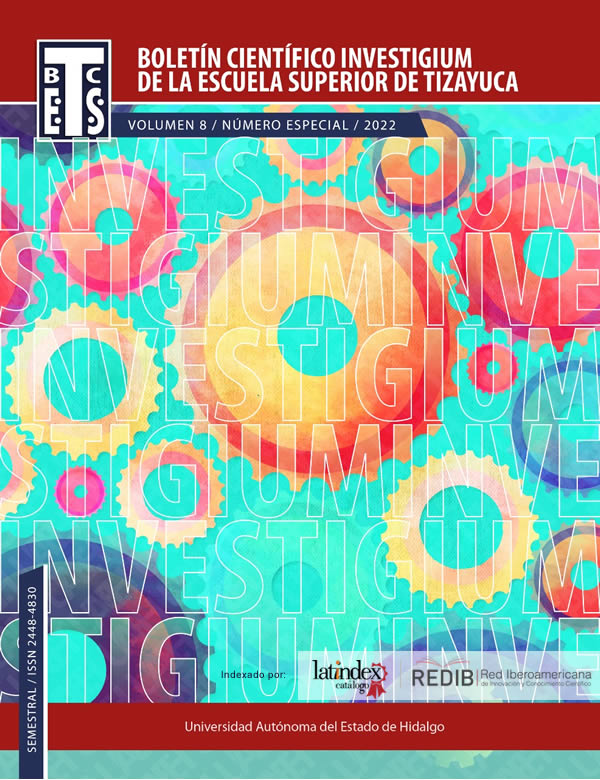Análisis de la respuesta magnética de YIG dopado con Ce3+, Nd3+ y Bi3+
DOI:
https://doi.org/10.29057/est.v8iEspecial.10082Palabras clave:
Granate de hierro itrio, Y3Fe5O12, YIG dopado, cerámicos magnéticos, molienda de alta energíaResumen
El granate de hierro itrio, YIG (Y3Fe5O12), es un cerámico con propiedades magnéticas, dieléctricas y ópticas, las cuales se atribuyen a su estructura cristalina. El YIG contiene 160 iones que forman huecos tetraédricos, octaédricos y dodecaédricos; así como a la ubicación de los cationes, distorsión e interacciones atómicas. Su baja coercitividad y mínimas pérdidas por corriente inducida es útil en dispositivos que operan en microondas. Con la finalidad de ampliar el rango de aplicaciones se sustituyen iones de Y3+ (1.019Å y 0 µB) por Ce3+ (1.01Å y 1.0 µB), Nd3+ (1.109Å y 3.62 µB) y Bi3+ (1.17Å y 0 µB). Se evalúa el efecto del tipo y nivel de dopaje, sobre la estructura cristalina y propiedades magnéticas del YIG dopado, cuando se emplea molienda de alta energía asistida con tratamiento térmico como método de síntesis
Descargas
Citas
E. J. J. Mallmann, A. Sombra, J. C. Goes, P. B. A. Fechine. Yttrium Iron Garnet: Properties and Applications Review. Solid State Phenomena. 2013; 202, 65-96,
Z. Cheng, H. Yang, Y. L., W. Xu. Saturation magnetic properties of Y3-xRexFe5O12 (Re: Gd, Dy, Nd, Sm and La) nanoparticles grown by a sol–gel method. J Mater Sci: Mater Electron. 2008; 19, 442–44.
A. Q. A. Mergen. Characterization of YIG nanopowders by mechanochemical synthesis. Journal of Alloys and Compounds. 2009; 478, 741–744.
F. F. W. Wan, N. S. A., K. Maslinda, F. A. Mohd, A. A. Zainal. Sintering and grain growth control of high dense YIG. Ceramics International. 2016; 42,13996–14005.
H. Z. L. J. L. Y. J. L. L. C. H. V. Jia N. Polycrystalline Bi substituted YIG ferrite processed via low temperature sintering. J. Alloys Compd. 2016; 695, 931-936.
M. Zeng. Co-precipitation synthesis of iron-containing garnets Y3Al5−xFexO12 and their magnetic properties. J. Magn. Magn. Mater. 393, 370–375, 2015.
R. Peña-Garcia, A. Delgado, Y. Guerra, B. V. M. Farias, D. Martinez, E. Skovroinski, A. Galembeck, E. Padron-Hernández. Magnetic and structural properties of Zn-doped yttrium iron garnet nanoparticles. Phys. Status Solidi A,1–7, 2016.
H. Y. L. Y. Y. C. S. F. Zhongjun Cheng. Preparation and magnetic properties of Y3Fe5O12 nanoparticles doped with the gadolinium oxide. Journal of Magnetism and Magnetic Materials. 302, 259–262, 2006.
M. Niyaifar y H. Mohammadpour. Study on magnetic role of Bi3+ ion by random cation distribution model in Bi-YIG system. Journal of Magnetism and magnetic materials. 396, 65-70, 2015.
N. Ibrahim, A. Arsad. Investigation of nanostructural, optical and magnetic properties of cerium-substituted yttrium iron garnet films prepared by a sol-gel method. Journal of Magnetism and Magnetic Materials. 401, 572–578, 2016
B. K. K. Vinay Sharma. Magnetic and crystallographic properties of rare-earth substituted yttrium-iron garnet. Journal of Alloys and Compounds. 2018; 748, 591-600
A. Akansha, S. Ravi. Structural, magnetic and dielectric properties of Cr substituted yttrium iron garnets. Journal of the American Ceramic Society. 2018.
Esperanza Baños-López, Félix Sánchez-De Jesús, Claudia A. Cortés-Escobedo, Arturo Barba-Pingarrón and Ana María Bolarín-Miró. Enhancement in Curie Temperature of Yttrium Iron Garnet by Doping with Neodymium. Materials, 11 (2018) 1652. Doi:10.3390/ma11091652
E. Baños-López, C. A. Cortés-Escobedo, F. Sánchez-De Jesús, A. Barba-Pingarrón, A. M. Bolarín-Miró. Crystal structure and magnetic properties of Cerium-doped YIG: Effect of doping concentration and annealing temperature. J. Alloys Compd. 730 (2018) 127-134.Doi: 10.1016/j.jallcom.2017.09.304


















